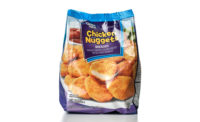True to Form (Fill and Seal)
By Lisa White, contributing writer
New technology and updated materials keep form, fill and seal packaging ahead of the curve.
Where packaging is concerned, faster production, longer product shelf life and cost savings are all at the top of meat processors’ lists. Luckily, the most recent innovations in the form, fill and seal packaging segment have focused on these enhancements.
Today’s newer equipment is more versatile and operates at higher speeds for greater throughput. Innovative packaging materials are providing more options than ever before, and the most recent technologies are increasing product shelf life without compromising food safety.
The form, fill and seal process is a fairly simple one. Forming machines use flexible, heat-sealable plastic film to form packages. Filling machines then load product. Finally, seal-only equipment wraps or seals the package.
Vertical or horizontal devices transport film, depending on the packaging, and while manual machines only set or hold products, semi-automatic machines assist with packaging and placement, cutting down the labor needed to operate the equipment. Fully automatic units also are available and require minimal operator intervention.
Extending shelf life
Don Oulton, regional sales manager for the southeast at PFM, an equipment supplier based in Toronto, Ontario, Canada, says modified-atmosphere packaging (MAP) has been the biggest innovation in the form, fill and seal segment in the last five years.
“It provides a longer shelf life without the use of additives,” he says. “MAP keeps the oxygen away from packaged products, replacing it with a gas mixture made up of primarily nitrogen.”
If the flow-wrapper is maintained, it has an airtight seal. “With this process, we always use barrier materials so oxygen can’t go through the film,” Oulton adds. MAP is more costly, mostly due to the added expense of the gas mixture, but it allows product to be shipped further because it increases the shelf life.
Another goal for meat processors is to find a way to produce more packages per minute. “Our technology has improved the process and speed for creating airtight or hermetic seals to address this need,” Oulton says.
Bill Chastain, vice president of Ulma Packaging, says modified-atmosphere tray overwrap individual packaging is popular with ground product, including sausage, beef and poultry.
“This is created using a horizontal form, fill and seal machine, which produces tray type packaging,” he explains. “Meat on the tray is then overwrapped with a barrier shrink film. In this process, we form a tub, insert the tray into it, then gas flush and hermetically seal the film ends.”
Hugh Crouch, manager of form, fill and seal technology at Ulma, describes another version that doesn’t use a gas flush procedure. “Instead, a breathable film is utilized to create a leak-resistant package,” Crouch says. “This is ideal for fresh cut up poultry.”
Chastain adds that most form, fill and seal technology is geared around being able to extend meat’s shelf life.
“Product needs to get through the distribution cycle with enough lead time to be sold at the retail level,” he says. Shelf life with MAP depends on the gas mix, but can average an extra 10 to 15 days, depending on the product.
“With pure vacuum packaging, the shelf life is between 28 and 30 days. With a low-oxygen process, the shelf life is between 21 and 24 days,” Chastain states.
Newer MAP machinery is advanced and includes automatic bagging that creates a shipping container. “There also have been improvements in skin-pack technology, film materials and equipment for this packaging. All of this is ongoing technology that continues to evolve,” Chastain says.
Speedy production
Speeding up the production process has also been a priority for South Easton, Mass.-based Harpak, according to Vin Faherty, product manager for the company’s packaging line. Harpak has developed radiant heating systems that can be used in conjunction with its horizontal packaging machines to accomplish precise thermoforming.
“This maximizes the heating profile of materials,” says Faherty. “What makes it unique is, it is a washed-down version for food-handling customers or those doing rigid material that need good production without line-speed pitfalls.”
Heating time is curtailed because the technology features a large-volume heating capacity. “We can get sheet temperatures up to 250 degrees quickly, unlike conventional contact heating, which takes more time to drive energy in,” Faherty explains.
This multiple-station technology, which is designed to maximize throughput and the thermoformability of material, can be used for any type of poultry, beef or pork, including ground product. In addition, the machine can thermoform either foam or plastic.
Although the unit’s main advantage is that it conducts thermoforming tasks in house, which saves costs, the technology is complicated and requires someone with expertise in performing this procedure, Faherty says. Another new development is Harpak’s stainless-steel washed-down cutting system that cuts in-line rigid material.
“This unique system allows machine operators to visually inspect forming and sealing features, allowing daily affirmations of the packaging’s integrity,” Faherty says, adding that it secures packaging from a maintenance standpoint. The equipment provides easy access for calibration and cleaning, in addition to an ergonomic design for added safety.
Also new is an infrared seal inspection station to ensure the seal’s integrity. “After thermoforming, this station verifies that the seal is secure,” Faherty says. “It is part of a fail-safe backup system we offer customers.”
Increased speed also was the impetus for the creation of Apex, N.C.-based Tipper Tie’s new clipping equipment. According to Dave Wince, eastern regional sales manager, the newest unit offers high-speed production that is twice the speed of its predecessor. In addition to saving space in the plant, it also offers labor savings since one machine does the work of two.
“We have been focusing on the American Meat Institute’s sanitary guidelines, as well,” Wince says. The machine can run sheared casing or collagen film and includes a self-diagnostics feature to pinpoint any operational problems quickly.
“This unit can be used with any emulsion-type product and connects to heat-sealing machines,” Wince says. Tipper Tie customers are seeing payback in throughput labor and maintenance savings after six to 14 months.
Tipper Tie introduced another labor-saving machine, geared for boneless hams and turkeys, this year. “This unit is geared for customers who want to hand lay product and stuff it in elastic, cotton or open-weave netting for further processing in the cooking cycle,” Wince says, adding that the labor savings with this machine is substantial.
Sanitation focus
Like Tipper Tie, Packaging Technologies in Davenport, Iowa, has kept a close eye on the AMI sanitation specifications.
According to Paul Wolf, food and filling engineering manager, the company’s chub maker series follows AMI’s washdown specification procedures for easy cleaning and maintenance.
“The stainless-steel unit has sealed and continuous welds and angled surfaces so it can be easily washed down,” he says. Creating this unit was a challenge, Wolf admits. “Following the AMI specifications wasn’t easy. It was difficult to get the machine to self-drain and [to] seal all of the metal joints. We had to keep the contact between metal at one square inch. But it is important to keep water off of the unit to prohibit bacterial growth,” he says.
Tony Alvarez, market development manager at Printpack, based in Atlanta, says there is a heavy emphasis on sanitation in form, fill and seal.
“Customers are looking for high-quality products in the case and packaging is an important aspect of these lines. There is more awareness of where food is coming from,” he says.
It is important for packaging material companies to work with OEMs in order to be tuned in to the market and its needs, Alvarez says. “Meat customers rely on OEMs for systems that provide solutions,” he explains.
Material innovations
On the material side, there have been some notable innovations. According to Curt Rubinstein, manager of sales and marketing at M&Q Packaging, of Schuylkill Haven, Pa., the company’s new barrier materials and packaging innovations have eliminated the cooking steps in meat processing. Because processors no longer need to cook or smoke product, they now can increase yield and reduce overhead while improving food-handling procedures.
“For 20 years, the packaging industry has been focused on cooking meat between 180 and 212 degrees,” says Rubinstein. “Then we evolved to microwave cooking. Today, we have an innovative film that affords high-temperature cooking at 400 degrees.”
This packaging creates a confined steam environment, so the heat and juice are retained in the package, resulting in greater yield and flavor with no mess, Rubinstein says. Also, the spread of pathogens is dramatically limited by the material.
“We can run a forming film for the package’s bottom portion on a thermoforming machine and nylon film for the lid stock. We can do the exact same thing with vertical of horizontal flow-wrappers, which is suitable for a variety of portion sizes,” Rubinstein says.
Also new in the material segment is a shrinkable rollstock film designed for forming machines. Ken Hynes, vice president and product manager for films at Avon, Ohio-based Carroll Manufacturing & Sales, says this film runs on horizontal thermoform machines and is designed to shrink around the meat. It can be used for products including chicken, roast beef and sausage.
“We offer three sizes, because it’s a mold that is size specific,” Hynes says. “The material shrinks on both sides around the product creating a high-clarity, glossy appearance.”
Another benefit of the new film is that it provides greater yield.
“It is a challenge developing new or specialized films that offer greater clarity, special sizing or better barriers. Customers are always trying to increase shelf life and create better packaging,” Hynes says.


